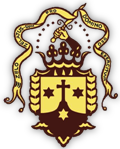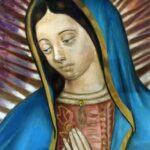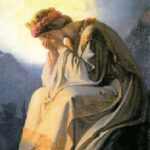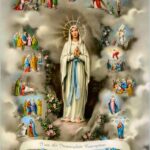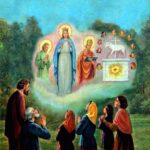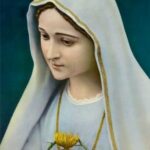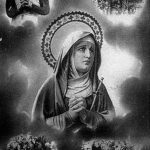The Apparitions of Knock
In Knock (‘Cnoc Mhuire’ in Gaelic, ‘Mary’s hill’), in County Mayo, in the west of Ireland, the Most Holy Virgin Mary, Most Holy Joseph, Saint John the Evangelist and Our Lord Jesus Christ as Lamb of God, all appeared to fifteen persons.
It was not an ordinary day; for just on that same day, the 21st of August 1879, Pope Saint Leo XIII formally granted canonical coronation to the image of Our Lady in Her Basilica of La Salette. This coincidence indicates a relation between Knock and the Message of La Salette, where the Virgin Most Holy foretold in 1846 the famine and potato shortage over the whole of Europe, but above all in Ireland, where more than a million died between 1845 and 1850.
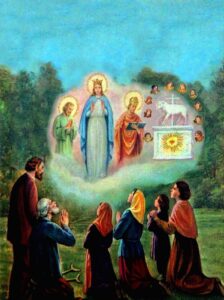 In Knock that Thursday the 21st of August 1879, it was a stormy night towards the end of the Irish summer. As usual, Mary Beirne, the lady in charge of the little Church, was about to lock the door. But something special called her attention: an intense light came from one side of the building, and there, at first sight, she seemed to see the statues of Mary Most Holy, of Saint Joseph and of Saint John, beside a new Altar on which there was a Lamb and a great Cross. She took little notice, since precisely on a stormy night like this one the previous year, two statues were damaged, so that she thought that the Parish Priest had bought them as replacements. But, why leave them out there under this heavy rain? – the woman asked herself.
In Knock that Thursday the 21st of August 1879, it was a stormy night towards the end of the Irish summer. As usual, Mary Beirne, the lady in charge of the little Church, was about to lock the door. But something special called her attention: an intense light came from one side of the building, and there, at first sight, she seemed to see the statues of Mary Most Holy, of Saint Joseph and of Saint John, beside a new Altar on which there was a Lamb and a great Cross. She took little notice, since precisely on a stormy night like this one the previous year, two statues were damaged, so that she thought that the Parish Priest had bought them as replacements. But, why leave them out there under this heavy rain? – the woman asked herself.
Later, together with Mary McLoughlin, she went back to see this wonder better, and with even greater stupor realized that the statues… were moving! It is the Virgin! – one of them cried out, and they ran off to tell family and friends. Thirteen persons joined them to complete the group of fifteen witnesses who were the basis of the testimony God wished to leave there.
This was how this very unusual Apparition appeared in all its reality: the entire side wall of the Church was illuminated by an intense light visible from afar. The figures were suspended in the air half a metre from the ground. Mary, the largest figure, was dressed in a white coloured mantle and had on a long veil from head to feet. The witnesses described the Most Holy Virgin Mary as very beautiful; She wore a white cape fastened at the collar. Upon Her head covered by the veil was a brilliant, extraordinary crown. The crown had a golden radiance; and yet more brilliant was the remarkable whiteness of Her dress. The upper part of the crown seemed to be a series of gleaming crosses. Between the crown and the edge of the veil She wore a brilliant rose. She was immersed in deep prayer, with eyes raised up to Heaven, hands raised to shoulder height in prayer, like the Priest’s hands in the traditional Mass, and Her gaze, absorbed in prayer, was turned heavenwards.
Most Holy Joseph, also dressed in white, was at Mary’s right, inclining his head towards Her and with hands joined, also in prayer. Saint John the Evangelist wore a Bishop’s mitre and long garments, and was at Mary’s left. His right hand was upraised and in his left arm held what seemed a Holy Bible. At Saint John’s left there was an Altar, and upon it a Lamb, and a Cross stood upon the Altar behind the Lamb. The Altar with the Lamb and the Cross were surrounded by Angels, circling.
While the group knelt before the Apparition in devout prayer, the heavenly visitors remained silent. Not a single word was spoken. The witnesses to the Apparition stayed out in the pouring rain for some two hours praying the Rosary. When the Apparition began it was twilight; but despite the darkness when night fell, the witnesses said that they could still see the figures quite clearly, seemingly the colour of a brilliant whitish light. The ground under the figures stayed completely dry during the Apparition, though a south wind blew. Nonetheless, after the Apparition, the ground became soaked and the wall was dark. Other villagers, who had not been at the Apparition, declared that they had seen a brilliant radiance lighting up the area around the Church.
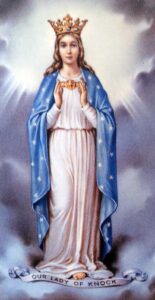
The Apparition, in this corner of Ireland hit by poverty and hunger, was a symbol of hope, consolation and strength amid misfortune, for it was a place in which unemployment and emigration were the order of the day.
What will the Lord have wanted to tell us with this scenario? The explanation, and the Message, of this Apparition could lie in the Apocalypse. Saint John bore a Book in his hands, and to discover Knock’s message, the Book of the Apocalypse must be studied. It is the book which contains the interpretation of Universal History. It is full of the great theme of Redemption in all its phases. There is the mystery of the “Lamb immolated from the beginning of the world,” the eternal plan of Redemption, so described by Saint John and represented by the Lamb upon the Altar seen in Knock.
Knock is a warning that chastisements are on the way: the cups of Divine Wrath and everything else announced in the Apocalypse. It also shows us the way to salvation, and indicates the Church’s fundamental doctrines for apocalyptic times. If in Lourdes the Most Holy Virgin highlighted the Dogma of Her Immaculate Conception, in Knock She ratifies Palmarian Teaching; for Mary Most Holy appears as Queen and as Co-Priest of Christ, in the posture of offering the Holy Sacrifice of Mass. Most Holy Joseph, assumed into Heaven, is there, teaching us to venerate his Most Holy Spouse; and Saint John the Evangelist announcing the imminent fulfilment of the Apocalypse. Our Lord Jesus Christ appears in Knock, as in the Apocalypse, as the Immolated Lamb, thus highlighting the central teachings of Palmarian Doctrine laid out in the Treatise on the Holy Mass, so that the Apparition at Knock is one more confirmation that the true Church of Christ is this one now sheltered in the mystical desert of Palmar.
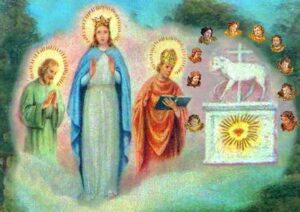
The Apparition of Knock was all in silence, and appeared to give no message, but in reality it was not so. At times silence is more eloquent than words. We must analyze the Apparition attentively to be able to discover the silent message it hides. Mary appears with Her earthly spouse, Saint Joseph, and with Her adopted son, Saint John the Evangelist. The Virgin wore the brilliant crown of Queen of Heaven. The Immolated Lamb shone out in the centre of the Altar, as seen by Saint John in the Apocalypse, upon the Altar of Heaven.
Knock is a Call to prayer and penance, as it highlights the importance of Holy Mass as perpetuation of the Sacrifice of the Cross on Calvary. The Apparition at Knock is a summary of the Treatise on the Holy Mass, with the Immolated Lamb, the Divine Victim on the Altar and on the Cross; Mary is there, Co-Victim, Co-Priest and Mediatrix of all Graces; Glorious Patriarch Saint Joseph is there, Co-Priest of Mary and Universal Mediator between Mary and all other creatures; Most Holy Joseph is indispensable in the Work of Reparation and Redemption, for at each Mass he has to hand over the finite sacrifices of the Church to be offered, and perpetuated or united; and the Ministerial Priest is there, who on Calvary was Saint John.
Each Apparition of the Most Holy Virgin has a different meaning, specially adapted to each circumstance and place. She, sent by Her Son, well knows our needs at each moment of history. And in this case She wanted to appear together with Her earthly Spouse, Saint Joseph, and Saint John the Evangelist, disciple so beloved of Jesus and of Herself.
Joseph is a symbol of heroism in purity, and John, an extraordinary sign of spiritual elevation, of faith lived in the form of passion and love. Joseph and John united, one as Virginal Father of Jesus and Virginal Spouse of the Mother of God, and the other as Priest, Bishop and Evangelist.
But the Apparition was also illumined by the presence of Angels, as a symbol of the accompaniment of God’s hosts, surrounding and unceasingly adoring the Word. The Angels surrounding the Altar indicate the great faith and reverence we should have when attending Holy Mass. It is all a clear reminder of the Apocalypse and of the times we are living in.
As from the first news of the Apparition, pilgrims continuously visited the Sanctuary, and hundreds of cures have been reported of the sick and disabled who made the journey. The fame of Knock thus spread beyond the coasts of Ireland.
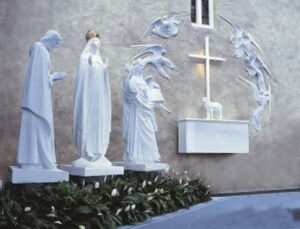
A few weeks after the Apparition, the Archbishop of Tuam, Saint John McHale, set up a Commission of Investigation. The fifteen witnesses were interrogated and the commission gave the verdict that the testimony of all, taken together, was trustworthy and satisfactory, so that worship by the faithful was not prevented at the site, which in time began to transform the village into a pilgrimage centre. The commission confirmed that no natural cause was possible, nor was there any fraud. The witnesses showed good faith at all times, and their testimonies were consistent. Nothing contrary to doctrine was found, quite the opposite; their account has a deep ecclesiastical sense. In 1936 another commission interrogated the three surviving witnesses, and definitively ratified that their evidence was honest and trustworthy. In 1945 Pope Saint Pius XII blessed the Knock banner and issued a special decorative medal.
The old church was enlarged and transformed into a Sanctuary, and a group of images representing the scene of the Apparition was set up close to the site of the old Church wall where the Apparition took place.
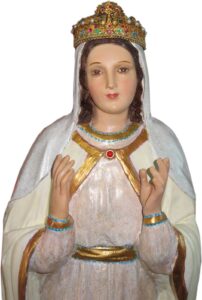 Miracles: At once there were miraculous cures among visitors to the Sanctuary, such as occur in many other Marian centres, like Lourdes and Fatima. In this way, God placed His own seal of authenticity on Knock, as He always does and will do with His veridical works.
Miracles: At once there were miraculous cures among visitors to the Sanctuary, such as occur in many other Marian centres, like Lourdes and Fatima. In this way, God placed His own seal of authenticity on Knock, as He always does and will do with His veridical works.
Ten days after the Apparition, the first cure occurred, that of a girl of twelve who had severe hearing difficulties. The girl’s mother related: “After the Apparition, I brought Delia. While we were in the Church, the pain in her ear grew so violent that she began to cry out. It was then that I took her outside, to the wall, scraped a little cement off the wall of the Apparition and placed it in her ear. She never felt the pain again from then on.” This account led to a multitude of pilgrims crowding the Church and beginning to break down the wall of the Apparition, since they took away bits of cement for cures and pieces of stone as mementos.
The Parish Priest of Knock, namely archdeacon Saint Bartholomew Louis Cavanagh, annotated details both of the extraordinary Apparition as also of the many miracles and cures taking place afterwards. These details were published, and produced great interest in the transcendent events at Knock, which soon became an important pilgrimage centre. Towards the end of 1880, some three hundred cures, seemingly miraculous, had already been registered in the Parish Priest’s diary. He is an ‘Apostle of Mary Immaculate and of Christian Charity’, and his feastday is the 8th of December.
Among Marian Apparitions, the case of the Knock Apparition has notable peculiarities which set it apart from other apparitions of the Virgin Mary. We will highlight some: The Virgin Mary did not come alone. She appeared accompanied by Most Holy Joseph and Saint John, with an Altar appearing too, surrounded by Angels and upon it a Lamb, and a great Cross behind the Altar. In this Apparition neither the Virgin nor anyone else spoke. Contrary to the more frequent apparitions of the Virgin to some children, generally humble and ignorant, in this case the Apparition was seen uninterruptedly during some three hours by all who began to arrive there, of all ages, from five to seventy-five, a total of fifteen seers. Without any explicit message, the Apparition itself links up with several Gospel and Apocalyptic passages, essentially with the Mystery of Reparation and Redemption, expressed here and in the Bible by the Lamb upon the Altar and the mention of the “Lamb of God”, who is to be sacrificed for the sins of men, and links up with the Old Testament Sacrifice of the lamb for God to forgive sins. And in relation to this scenario, it is the first time that a great Cross appears, which clearly represents the Reparation and Redemption.
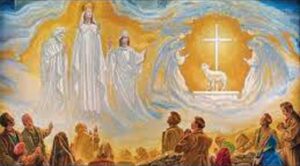 In August 1979, Knock’s Centenary month and year, Pope Saint Gregory XVII visited the sacred place, thus confirming Knock as one of the principal Marian Sanctuaries of the world. Pope Saint Gregory XVII’s visit to Knock is thus described in the book of his Messages: “6th of August 1979: Monday. Ireland. First Anniversary of His Holiness Gregory XVII’s papal election. In the morning we set out to travel to the Sanctuary of Our Lady of Knock, proclaimed Exalted Patroness of Ireland by His Holiness Pope Gregory XVII on the 23rd of November 1978, and whose Apparition centenary is commemorated on the 21st of this month. His Holiness Pope Gregory XVII arrived at this Sanctuary at about 3 in the afternoon, and was received by the numerous faithful with cheers and applause. First he visited the old Sanctuary, and led a mystery of the Penitential Rosary before an Image of the Virgin of Knock. We sang some canticles in Her honour, and at the end the Holy Father gave the Apostolic Blessing, sung with all solemnity. He then went on to the exact spot of the Apparition, where there is a beautiful Image of the Titular Virgin, of Saint Joseph and of Saint John the Evangelist with the Apocalypse in his hand. There the Magnificat was sung, and at the end the Holy Father again gave the Apostolic Blessing, solemnly sung. All the faithful devotees who filled that Sacred Place broke out in cries of “Viva el Papa Gregorio XVII”, with enthusiastic applause for His Holiness. Many of the people there, not knowing of El Palmar, went up to kiss the Holy Father’s ring with all reverence. We returned to Dublin, and at 11.30 at night Pope Gregory XVII celebrated Holy Mass in our Chapel-Cathedral in that city. During Mass he had the following vision: He saw the Lord, the Most Holy Virgin, Saint Joseph, Saint Peter, Saint Paul and Saint Paul VI.”
In August 1979, Knock’s Centenary month and year, Pope Saint Gregory XVII visited the sacred place, thus confirming Knock as one of the principal Marian Sanctuaries of the world. Pope Saint Gregory XVII’s visit to Knock is thus described in the book of his Messages: “6th of August 1979: Monday. Ireland. First Anniversary of His Holiness Gregory XVII’s papal election. In the morning we set out to travel to the Sanctuary of Our Lady of Knock, proclaimed Exalted Patroness of Ireland by His Holiness Pope Gregory XVII on the 23rd of November 1978, and whose Apparition centenary is commemorated on the 21st of this month. His Holiness Pope Gregory XVII arrived at this Sanctuary at about 3 in the afternoon, and was received by the numerous faithful with cheers and applause. First he visited the old Sanctuary, and led a mystery of the Penitential Rosary before an Image of the Virgin of Knock. We sang some canticles in Her honour, and at the end the Holy Father gave the Apostolic Blessing, sung with all solemnity. He then went on to the exact spot of the Apparition, where there is a beautiful Image of the Titular Virgin, of Saint Joseph and of Saint John the Evangelist with the Apocalypse in his hand. There the Magnificat was sung, and at the end the Holy Father again gave the Apostolic Blessing, solemnly sung. All the faithful devotees who filled that Sacred Place broke out in cries of “Viva el Papa Gregorio XVII”, with enthusiastic applause for His Holiness. Many of the people there, not knowing of El Palmar, went up to kiss the Holy Father’s ring with all reverence. We returned to Dublin, and at 11.30 at night Pope Gregory XVII celebrated Holy Mass in our Chapel-Cathedral in that city. During Mass he had the following vision: He saw the Lord, the Most Holy Virgin, Saint Joseph, Saint Peter, Saint Paul and Saint Paul VI.”
In Knock (‘Cnoc Mhuire’ in Gaelic, ‘Mary’s hill’), in County Mayo, in the west of Ireland, the Most Holy Virgin Mary, Most Holy Joseph, Saint John the Evangelist and Our Lord Jesus Christ as Lamb of God, all appeared to fifteen persons.
It was not an ordinary day; for just on that same day, the 21st of August 1879, Pope Saint Leo XIII formally granted canonical coronation to the image of Our Lady in Her Basilica of La Salette. This coincidence indicates a relation between Knock and the Message of La Salette, where the Virgin Most Holy foretold in 1846 the famine and potato shortage over the whole of Europe, but above all in Ireland, where more than a million died between 1845 and 1850.

In Knock that Thursday the 21st of August 1879, it was a stormy night towards the end of the Irish summer. As usual, Mary Beirne, the lady in charge of the little Church, was about to lock the door. But something special called her attention: an intense light came from one side of the building, and there, at first sight, she seemed to see the statues of Mary Most Holy, of Saint Joseph and of Saint John, beside a new Altar on which there was a Lamb and a great Cross. She took little notice, since precisely on a stormy night like this one the previous year, two statues were damaged, so that she thought that the Parish Priest had bought them as replacements. But, why leave them out there under this heavy rain? – the woman asked herself.
Later, together with Mary McLoughlin, she went back to see this wonder better, and with even greater stupor realized that the statues… were moving! It is the Virgin! – one of them cried out, and they ran off to tell family and friends. Thirteen persons joined them to complete the group of fifteen witnesses who were the basis of the testimony God wished to leave there.
This was how this very unusual Apparition appeared in all its reality: the entire side wall of the Church was illuminated by an intense light visible from afar. The figures were suspended in the air half a metre from the ground. Mary, the largest figure, was dressed in a white coloured mantle and had on a long veil from head to feet. The witnesses described the Most Holy Virgin Mary as very beautiful; She wore a white cape fastened at the collar. Upon Her head covered by the veil was a brilliant, extraordinary crown. The crown had a golden radiance; and yet more brilliant was the remarkable whiteness of Her dress. The upper part of the crown seemed to be a series of gleaming crosses. Between the crown and the edge of the veil She wore a brilliant rose. She was immersed in deep prayer, with eyes raised up to Heaven, hands raised to shoulder height in prayer, like the Priest’s hands in the traditional Mass, and Her gaze, absorbed in prayer, was turned heavenwards.
Most Holy Joseph, also dressed in white, was at Mary’s right, inclining his head towards Her and with hands joined, also in prayer. Saint John the Evangelist wore a Bishop’s mitre and long garments, and was at Mary’s left. His right hand was upraised and in his left arm held what seemed a Holy Bible. At Saint John’s left there was an Altar, and upon it a Lamb, and a Cross stood upon the Altar behind the Lamb. The Altar with the Lamb and the Cross were surrounded by Angels, circling.
While the group knelt before the Apparition in devout prayer, the heavenly visitors remained silent. Not a single word was spoken. The witnesses to the Apparition stayed out in the pouring rain for some two hours praying the Rosary. When the Apparition began it was twilight; but despite the darkness when night fell, the witnesses said that they could still see the figures quite clearly, seemingly the colour of a brilliant whitish light. The ground under the figures stayed completely dry during the Apparition, though a south wind blew. Nonetheless, after the Apparition, the ground became soaked and the wall was dark. Other villagers, who had not been at the Apparition, declared that they had seen a brilliant radiance lighting up the area around the Church.

The Apparition, in this corner of Ireland hit by poverty and hunger, was a symbol of hope, consolation and strength amid misfortune, for it was a place in which unemployment and emigration were the order of the day.
What will the Lord have wanted to tell us with this scenario? The explanation, and the Message, of this Apparition could lie in the Apocalypse. Saint John bore a Book in his hands, and to discover Knock’s message, the Book of the Apocalypse must be studied. It is the book which contains the interpretation of Universal History. It is full of the great theme of Redemption in all its phases. There is the mystery of the “Lamb immolated from the beginning of the world,” the eternal plan of Redemption, so described by Saint John and represented by the Lamb upon the Altar seen in Knock.
Knock is a warning that chastisements are on the way: the cups of Divine Wrath and everything else announced in the Apocalypse. It also shows us the way to salvation, and indicates the Church’s fundamental doctrines for apocalyptic times. If in Lourdes the Most Holy Virgin highlighted the Dogma of Her Immaculate Conception, in Knock She ratifies Palmarian Teaching; for Mary Most Holy appears as Queen and as Co-Priest of Christ, in the posture of offering the Holy Sacrifice of Mass. Most Holy Joseph, assumed into Heaven, is there, teaching us to venerate his Most Holy Spouse; and Saint John the Evangelist announcing the imminent fulfilment of the Apocalypse. Our Lord Jesus Christ appears in Knock, as in the Apocalypse, as the Immolated Lamb, thus highlighting the central teachings of Palmarian Doctrine laid out in the Treatise on the Holy Mass, so that the Apparition at Knock is one more confirmation that the true Church of Christ is this one now sheltered in the mystical desert of Palmar.

The Apparition of Knock was all in silence, and appeared to give no message, but in reality it was not so. At times silence is more eloquent than words. We must analyze the Apparition attentively to be able to discover the silent message it hides. Mary appears with Her earthly spouse, Saint Joseph, and with Her adopted son, Saint John the Evangelist. The Virgin wore the brilliant crown of Queen of Heaven. The Immolated Lamb shone out in the centre of the Altar, as seen by Saint John in the Apocalypse, upon the Altar of Heaven.
Knock is a Call to prayer and penance, as it highlights the importance of Holy Mass as perpetuation of the Sacrifice of the Cross on Calvary. The Apparition at Knock is a summary of the Treatise on the Holy Mass, with the Immolated Lamb, the Divine Victim on the Altar and on the Cross; Mary is there, Co-Victim, Co-Priest and Mediatrix of all Graces; Glorious Patriarch Saint Joseph is there, Co-Priest of Mary and Universal Mediator between Mary and all other creatures; Most Holy Joseph is indispensable in the Work of Reparation and Redemption, for at each Mass he has to hand over the finite sacrifices of the Church to be offered, and perpetuated or united; and the Ministerial Priest is there, who on Calvary was Saint John.
Each Apparition of the Most Holy Virgin has a different meaning, specially adapted to each circumstance and place. She, sent by Her Son, well knows our needs at each moment of history. And in this case She wanted to appear together with Her earthly Spouse, Saint Joseph, and Saint John the Evangelist, disciple so beloved of Jesus and of Herself.
Joseph is a symbol of heroism in purity, and John, an extraordinary sign of spiritual elevation, of faith lived in the form of passion and love. Joseph and John united, one as Virginal Father of Jesus and Virginal Spouse of the Mother of God, and the other as Priest, Bishop and Evangelist.
But the Apparition was also illumined by the presence of Angels, as a symbol of the accompaniment of God’s hosts, surrounding and unceasingly adoring the Word. The Angels surrounding the Altar indicate the great faith and reverence we should have when attending Holy Mass. It is all a clear reminder of the Apocalypse and of the times we are living in.
As from the first news of the Apparition, pilgrims continuously visited the Sanctuary, and hundreds of cures have been reported of the sick and disabled who made the journey. The fame of Knock thus spread beyond the coasts of Ireland.

A few weeks after the Apparition, the Archbishop of Tuam, Saint John McHale, set up a Commission of Investigation. The fifteen witnesses were interrogated and the commission gave the verdict that the testimony of all, taken together, was trustworthy and satisfactory, so that worship by the faithful was not prevented at the site, which in time began to transform the village into a pilgrimage centre. The commission confirmed that no natural cause was possible, nor was there any fraud. The witnesses showed good faith at all times, and their testimonies were consistent. Nothing contrary to doctrine was found, quite the opposite; their account has a deep ecclesiastical sense. In 1936 another commission interrogated the three surviving witnesses, and definitively ratified that their evidence was honest and trustworthy. In 1945 Pope Saint Pius XII blessed the Knock banner and issued a special decorative medal.
The old church was enlarged and transformed into a Sanctuary, and a group of images representing the scene of the Apparition was set up close to the site of the old Church wall where the Apparition took place.

Miracles: At once there were miraculous cures among visitors to the Sanctuary, such as occur in many other Marian centres, like Lourdes and Fatima. In this way, God placed His own seal of authenticity on Knock, as He always does and will do with His veridical works.
Ten days after the Apparition, the first cure occurred, that of a girl of twelve who had severe hearing difficulties. The girl’s mother related: “After the Apparition, I brought Delia. While we were in the Church, the pain in her ear grew so violent that she began to cry out. It was then that I took her outside, to the wall, scraped a little cement off the wall of the Apparition and placed it in her ear. She never felt the pain again from then on.” This account led to a multitude of pilgrims crowding the Church and beginning to break down the wall of the Apparition, since they took away bits of cement for cures and pieces of stone as mementos.
The Parish Priest of Knock, namely archdeacon Saint Bartholomew Louis Cavanagh, annotated details both of the extraordinary Apparition as also of the many miracles and cures taking place afterwards. These details were published, and produced great interest in the transcendent events at Knock, which soon became an important pilgrimage centre. Towards the end of 1880, some three hundred cures, seemingly miraculous, had already been registered in the Parish Priest’s diary. He is an ‘Apostle of Mary Immaculate and of Christian Charity’, and his feastday is the 8th of December.
Among Marian Apparitions, the case of the Knock Apparition has notable peculiarities which set it apart from other apparitions of the Virgin Mary. We will highlight some: The Virgin Mary did not come alone. She appeared accompanied by Most Holy Joseph and Saint John, with an Altar appearing too, surrounded by Angels and upon it a Lamb, and a great Cross behind the Altar. In this Apparition neither the Virgin nor anyone else spoke. Contrary to the more frequent apparitions of the Virgin to some children, generally humble and ignorant, in this case the Apparition was seen uninterruptedly during some three hours by all who began to arrive there, of all ages, from five to seventy-five, a total of fifteen seers. Without any explicit message, the Apparition itself links up with several Gospel and Apocalyptic passages, essentially with the Mystery of Reparation and Redemption, expressed here and in the Bible by the Lamb upon the Altar and the mention of the “Lamb of God”, who is to be sacrificed for the sins of men, and links up with the Old Testament Sacrifice of the lamb for God to forgive sins. And in relation to this scenario, it is the first time that a great Cross appears, which clearly represents the Reparation and Redemption.

In August 1979, Knock’s Centenary month and year, Pope Saint Gregory XVII visited the sacred place, thus confirming Knock as one of the principal Marian Sanctuaries of the world. Pope Saint Gregory XVII’s visit to Knock is thus described in the book of his Messages: “6th of August 1979: Monday. Ireland. First Anniversary of His Holiness Gregory XVII’s papal election. In the morning we set out to travel to the Sanctuary of Our Lady of Knock, proclaimed Exalted Patroness of Ireland by His Holiness Pope Gregory XVII on the 23rd of November 1978, and whose Apparition centenary is commemorated on the 21st of this month. His Holiness Pope Gregory XVII arrived at this Sanctuary at about 3 in the afternoon, and was received by the numerous faithful with cheers and applause. First he visited the old Sanctuary, and led a mystery of the Penitential Rosary before an Image of the Virgin of Knock. We sang some canticles in Her honour, and at the end the Holy Father gave the Apostolic Blessing, sung with all solemnity. He then went on to the exact spot of the Apparition, where there is a beautiful Image of the Titular Virgin, of Saint Joseph and of Saint John the Evangelist with the Apocalypse in his hand. There the Magnificat was sung, and at the end the Holy Father again gave the Apostolic Blessing, solemnly sung. All the faithful devotees who filled that Sacred Place broke out in cries of “Viva el Papa Gregorio XVII”, with enthusiastic applause for His Holiness. Many of the people there, not knowing of El Palmar, went up to kiss the Holy Father’s ring with all reverence. We returned to Dublin, and at 11.30 at night Pope Gregory XVII celebrated Holy Mass in our Chapel-Cathedral in that city. During Mass he had the following vision: He saw the Lord, the Most Holy Virgin, Saint Joseph, Saint Peter, Saint Paul and Saint Paul VI.”
